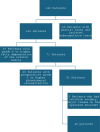Factors affecting medium-term patient satisfaction after arthroscopic repair of small to medium-sized rotator cuff tears: An observational study
- PMID: 38758912
- PMCID: PMC11098260
- DOI: 10.1097/MD.0000000000038211
Factors affecting medium-term patient satisfaction after arthroscopic repair of small to medium-sized rotator cuff tears: An observational study
Abstract
This study aimed to assess the effect of the status of the tendon and patient factors on patient satisfaction after rotator cuff repair. Forty-six patients treated for tears with a minimum of 5-year follow-up were included. Gender, age, and active smoking status were recorded. Pain visual analogue scale, American Shoulder and Elbow Surgeons Standardized Shoulder Assessment Form, Simple Shoulder Test, and Single Assessment Numeric Evaluation were recorded preoperatively and at the last follow-up. Patients were divided into groups of highly satisfied (HS) and vaguely satisfied (VS) patients. Patients were evaluated with MRI both preoperatively and at their last follow-up. Of the 46 patients, 17 were HS and 29 were VS. The HS group had 7 re-ruptures, 4 of which were progressed tears, whereas the VS group had 15 re-ruptures, 4 of which were progressed tears. There was no difference in the rate of re-ruptures or progressed tears between groups. The HS group had a higher frequency of males. However, frequencies of active smoking or osteoarthritis of grade 2 or higher were lower in the HS group. It was shown that patient satisfaction after repair depends on patient-related factors like gender and smoking rather than tendon healing or degeneration.
Copyright © 2024 the Author(s). Published by Wolters Kluwer Health, Inc.
Conflict of interest statement
The authors have no funding and conflicts of interest to disclose.
References
-
- Spennacchio P, Banfi G, Cucchi D, D’Ambrosi R, Cabitza P, Randelli P. Long-term outcome after arthroscopic rotator cuff treatment. Knee Surg Sports Traumatol Arthrosc. 2015;23:523–9. - PubMed
-
- Cvetanovich GL, Gowd AK, Liu JN, et al. . Establishing clinically significant outcome after arthroscopic rotator cuff repair. J Shoulder Elbow Surg. 2019;28:939–48. - PubMed
-
- Kim DM, Kim TK, Kholinne E, et al. . Minimal clinically important difference, substantial clinical benefit, and patient acceptable symptomatic state after arthroscopic rotator cuff repair. Am J Sports Med. 2020;48:2650–9. - PubMed
Publication types
MeSH terms
LinkOut - more resources
Full Text Sources
Medical


